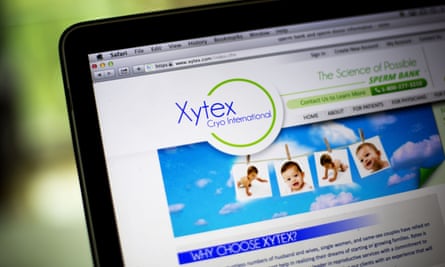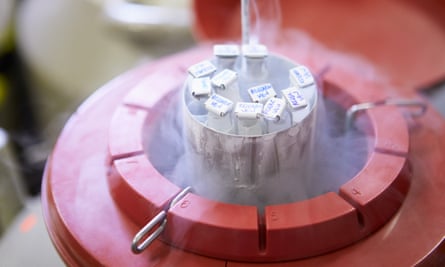Sperm donor 9623 looked good on paper. An IQ of 160. A bachelor’s degree in neuroscience, a master’s in artificial intelligence, en route to a PhD in neuroscience engineering. A passion for “crystallography, algorithms and fitness”. Ontario couple Elizabeth Hanson and Angela Collins thought they had found the perfect father for their baby.
Seven years after their son was born, Collins and Hanson discovered that donor 9623 was a college dropout with schizophrenia, a narcissistic personality disorder and a criminal history. He had spent eight months in prison for burglary, and 10 years on probation.
The sperm bank had inadvertently included the donor’s name, Christian Aggeles, in an email to the couple. A Google search did the rest. His stepfather had testified in court that Aggeles’s psychotic episodes began aged 19, well before he started donating in Georgia. Aggeles’s sperm led to the birth of at least 36 children worldwide.
“It was like a dream turned nightmare in an instant,” said Collins. The couple, alongside at least three other families, have filed lawsuits against the Georgia-based sperm bank, Xytex Corporation, which also supplied sperm to British couples. Xytex denies wrongdoing.
Such cases are not unique. Like Collins, Hanson and their son, many families and individuals are now coming to terms with vital information that their donors withheld.
The ramifications of such discoveries can be immense. “The most important entity to me is [my son] potentially facing a very debilitating lifestyle,” Collins says. “I felt like I was duped by Xytex and I failed my son for having chosen Xytex. In hindsight, a hitchhiker on the side of the road would have been a far more responsible option for conceiving a child.”

What level of risk do Aggeles’s genes confer? The architecture of mental health disorders is complex. The genetic component of schizophrenia, explains Professor Cathryn Lewis, professor of genetic epidemiology and statistics at King’s College London, is not a single gene, but is combined across many genes. “There are likely to be thousands of inherited variants that control risk of schizophrenia. Each change slightly increases or decreases our risk, but none of them alone will enable us to predict whether someone is likely to develop schizophrenia.”
Even exciting new findings in the C4 gene require careful interpretation. “It’s a single piece in a large genetic jigsaw puzzle,” Lewis says. “Testing one gene tells us nothing about an individual’s risk of developing schizophrenia.”
Mental health conditions also reflect a mix of interacting environment and social factors. Not to mention that many people with schizophrenia respond to treatment and live full, productive lives.
Donor anonymity was abolished in the UK in 2005. Donor-conceived offspring are now legally entitled, at the age of 18, to information on their donor’s identity. However, this was not retrospectively applied: those conceived before April 2005 (that’s 21,000 people born between 1991 and 2004 alone) cannot identify their donor unless the donor steps forward voluntarily. Some are never even told they were donor-conceived in the first place.
Tyler Blackwell discovered as a teenager in Maryland that he has 35 half-siblings. His second surprise: having the same condition that his donor father, John (not his real name) had not revealed. John’s sister found the Blackwells through a family ancestry site. It transpired that John, who had not replied to their correspondence, had an aortic aneurysm, which had ruptured at the age of 43. He had survived. At least three other family members were similarly affected. Tyler saw a cardiologist as a precaution, was diagnosed with an aneurysm and underwent surgery. Without an operation on an aneurysm of this type, the mortality from rupture is up to 97%. When rupture occurs, patients usually die within six hours. “There is no one who knew about it,” said his mother of the sperm bank involved. “If I could foretell the future, I would have picked a different donor.”
Financial incentives could underlie some instances of deception. However, the UK’s Human Fertilisation and Embryology Authority (HFEA) sets the limit for sperm donors at £35 per clinic visit and egg donors at £750 per cycle of donation, plus expenses. These limits, it states, aim to reward altruism and discourage coercion. Rules vary internationally. One California cryobank “reimburses your time and expenses with compensation of up to $1,500/month” with “periodic incentives such as movie tickets or gift certificates for extra time and effort expended by participants”.
Danish sperm donor 7042 unwittingly passed on neurofibromatosis to at least 11 of his children, after his sperm was used in clinics across the US, Canada, Belgium, Greece, Spain, Thailand and the UK. Neurofibromatosis is associated with brain and nerve tumours, bone deformities, visual impairment, high blood pressure and learning difficulties. Offspring have a 50% risk of inheriting it. Denmark has since mandated that donor sperm can be used in a maximum of 12 inseminations. In the UK, no more than 10 families can be created using egg or sperm from a single donor. Donated eggs are not risk-free, but sperm donors usually have more offspring who can pass on inherited conditions to the next generation.
There is no such thing as reproduction without risk. There is, however, an ethical responsibility towards the child to be conceived and their hopeful parents. If a donor develops a genetic condition years after donation, there is no system at present that enforces disclosure.
Donors now must test negative for HIV, hepatitis B and C, and syphilis, with further screening informed by ethnicity – such as cystic fibrosis in those of Caucasian descent and sickle-cell disease in African and Afro-Caribbean populations. Guidelines state that potential donors should be assessed for conditions with a genetic component – cleft palate, spina bifida, congenital heart malformations, psychosis and others – but that decisions on eligibility should be individualised.
These screening regulations do not always apply to the unknown number of UK citizens who travel abroad to find donors, use unlicensed clinics or buy home-insemination kits online. Although psychological evaluation is required by most international authorities, this will not bar donors who have not yet developed symptoms of a serious mental health disorder. For them, the diagnostic tool is time.
Genetic screening is more affordable and comprehensive than ever before. So, should we turn away from the donor’s account and towards the laboratory? Allan Pacey, professor of andrology at the University of Sheffield, is wary. “I think the perfect genome probably doesn’t exist, so it’s really a question of where the line should be drawn. Only about 4% of men who come forward to be sperm donors are accepted. If we were to impose a whole new set of exclusion criteria based on theoretical risks, it is possible there won’t be any sperm donors at all.”

With enhanced screening, donors might be diagnosed with genetic conditions that would have remained undiscovered for ever, or are untreatable. Perhaps there is an argument for not knowing.
Kevin, who works in photography in London, is not only a donor-conceived person but a donor himself. He believes that prospective parents should know as much as possible about the donor’s medical history. “But there is a point where you have to draw the line, and say we’re not creating designer babies here,” he adds.
He understands the distress of Elizabeth Hanson and Angela Collins, yet worries about reading too much into specific cases. “It’s a shame if people let it overshadow the industry and take it to be some sort of wide-reaching corruption. It is one story. Every day there are lots of babies being born to couples who have fertility problems and that’s much more important to remember.”
Eleven offspring have been born from his donations. Why did he donate? “I wouldn’t be here if someone hadn’t donated. Somebody did that and that’s why I am here.”
Jess Cresswell discovered aged 28 that she was donor-conceived. Seven years later, she still does not know who her biological father is, but feels her parents gave her the best life they could. Since some of her own family medical history is missing, how does she feel about donor screening?
“I think they should be screened but I also think that, just because they have some sort of hereditary condition, they shouldn’t necessarily be excluded. It’s the parents’ discretion; some people would rather have a child knowing there’s a risk of picking something up than not, if that was their only option.”
It is now easier than ever for donor-conceived people to find their genetic family. The US Donor Sibling Registry has helped connect more than 10,900 people with their half-siblings and/or their donors. Nearly 70% of those who sign up match with a biological relative, and almost 80% of this group match instantly. The UK has a Donor Sibling Link site.
Direct-to-consumer genetic tests have revolutionised this space. In 2005, a 15-year-old sent a saliva sample to an online service, had his genetic code uploaded, used a tracking website and met his biological father 10 days later. Kevin found a half-sister through a donor-sibling registry and two half-siblings through ancestry sites. He later inadvertently discovered some of his donor’s details. Two hours on, Google revealed his donor’s name. The two have since stayed in contact.
One last thing: Aggeles received mental health treatment and picked up a degree in cognitive science two decades after he first registered at university. He is now working on a master’s in artificial intelligence.

Comments (…)
Sign in or create your Guardian account to join the discussion